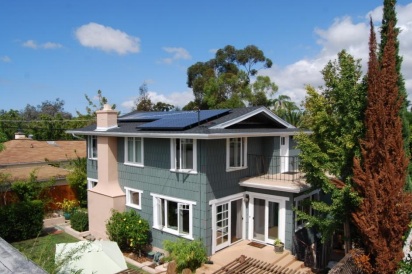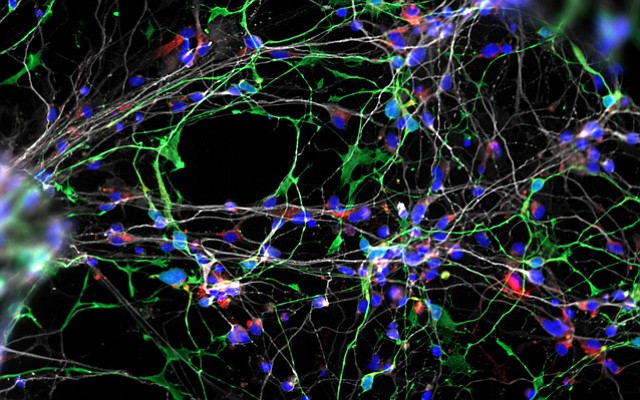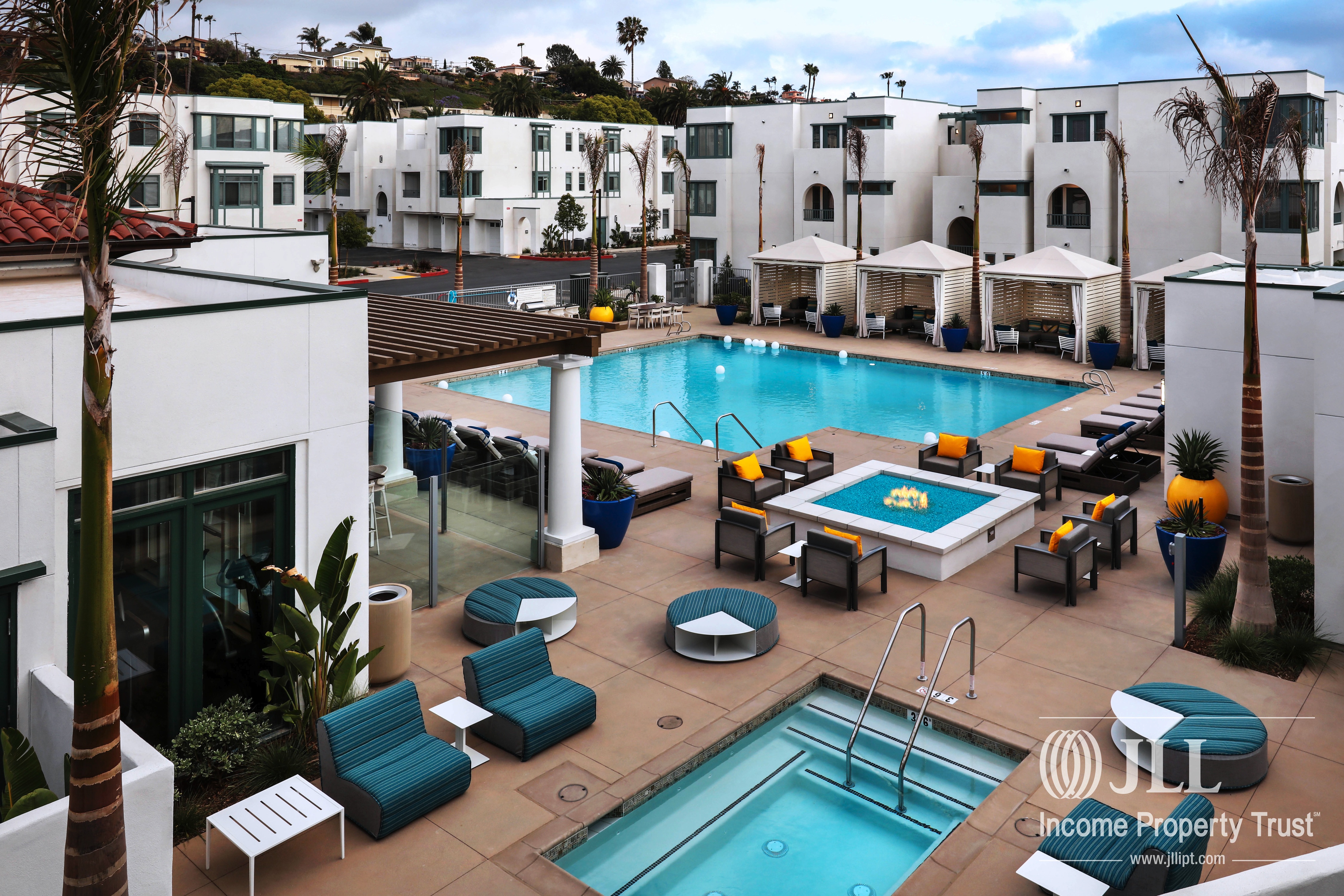Daily Business Report-Aug. 11, 2016
The 180-unit Dylan Point Loma apartment community. (Courtesy JLL Income Property Trust)
Chicago REIT Acquires Point Loma
Luxury Apartments for $90 Million
JLL Income Property Trust, a real estate investment trust, has acquired Dylan Point Loma, a newly-developed, ultra-luxury 180-unit coastal apartment community in Point Loma, for $90 million.
Besides the 180 townhomes with attached garages, Dylan Point Loma has
a 6,000-square-foot community clubhouse, resort-style saltwater pool and spa with cabanas and luxury lounges, fitness equipment, volleyball court, barbeque areas, landscaping and open spaces. It is located at 2930 Barnard St.
“Dylan Point Loma exemplifies our core apartment investment strategy,” said Allan Swaringen, president and CEO of JLL Income Property Trust, which is based in Chicago. “We committed to this investment over a year ago and will complete the property’s lease up in keeping with our ‘lease to core’ apartment strategy.”
LaSalle ranks the San Diego Downtown and coastal close-in apartment market as one of the top five target markets for core apartment investing in the U.S. It said the market is perennially among the most supply constrained in the U.S. where vacancies have averaged below 4 percent during the past 10 years, compared to the national average apartment vacancy of 5.5 percent.
San Diego is also a top-ranking market in terms of rent growth and LaSalle’s Market Tracking System forecasts continued strong rent growth driven by low vacancies, steady job growth in San Diego’s technology, tourism, biotech and defense sectors, and limited new construction, according to LaSalle.Currently, San Diego has one of the lowest apartment vacancy rates in the country at 2.5 percent, with vacancies in the Point Loma submarket reaching 2 percent.
__________________________________________
Intel Corp. Agrees to Acquire
San Diego Startup Nervana Systems
Investor Place
Intel Corp. has announced that it is planning to purchase San Diego-based startup Nervana Systems.
Intel’s acquisition on Nervana will add to its portfolio and allow the smaller company to continue its efforts in deep learning. Nervana will continue to operate out of its headquarters in San Diego. It will also keep its current employees and brand after the acquisition is completed.
Nervana said that it will still be working on its same projects after the acquisition by Intel. This includes its Nervana Neon deep learning framework, Nervana deep learning platform, and the Nervana Engine deep learning hardware.
“Their IP and expertise in accelerating deep learning algorithms will expand Intel’s capabilities in the field of AI,” Diane Bryant, the executive vice president and general manager of Intel’s Data Center Group, said in a statement.
. “We will apply Nervana’s software expertise to further optimize the Intel Math Kernel Library and its integration into industry standard frameworks.
Neither Intel or Nervana announced specific details of the deal. However, reports from insider sources told Recode that the chip maker payed over $400 million for the startup. One source claimed that the exact amount INTC is spending to acquire Nervana is $408 million.
Nervana is a small startup that has 48 employees. It has raised over $25 million in funding from investors and was founded in 2014. The company is led by Naveen Rao, a former researcher for Qualcomm Inc. He said the deal will give the startup access to “technology we’d never dream about.”
__________________________________________
Council Rejects Cost-Saving
Plan for 2 Lengthy Initiatives
Times of San Diego
The San Diego City Council has rejected a cost-saving plan to place the texts of two lengthy citizen initiatives online, which means officials will mail to voters pamphlets containing the information.
The pamphlets will supplement the normal informational pamphlets voters will receive before the November election.
“To me, this is more about making sure everybody has the information in front of them in order to cast an informed vote,” Councilman Scott Sherman said Wednesday at a special meeting.
One of the initiatives would fund construction of a Chargers stadium and convention center annex. The other would prohibit a waterfront expansion of the current convention center and encourage educational and park uses of the Qualcomm Stadium site if the local National Football League franchise vacates the premises.
Both need voter approval because they would raise hotel room taxes.
The text of the initiatives will total nearly 200 pages when printed, and they’re just two of a dozen city propositions on the ballot. In addition, there are a few countywide ballot measures and 17 state questions that will go before voters in November.
__________________________________________

Green Building Council’s Annual
Green Home Tour Set for Nov. 12
The San Diego Green Building Council’s seventh annual Green Home Tour will be held on Saturday, Nov. 12, at multiple home sites throughout the county.
Each year, the event brings together hundreds of members of the local community to celebrate best practices in green building and design while showcasing the innovative work of some of the industry’s top professionals. The diverse projects include sustainably remodeled residences, urban multifamily developments, luxurious custom homes and many projects that have achieved or are seeking LEED (Leadership in Energy and Environmental Design) certification, the top third-party verification system for sustainable structures around the world.
On the self-guided tour, attendees may visit as many of the homes as they would like, meet with industry professionals and learn more about the latest green home design, construction and upgrade options. Each eco-friendly project features a number of innovative, high-performance design features including impact areas such as energy, water conservation, building materials, indoor air quality, landscaping, and sustainable building sites.
The council is still accepting submissions for unique residential projects throughout the county to showcase in the 2016 tour. The deadline to nominate a project is Friday, Sept. 9. Click here to submit.
Tickets are $10 for council members and $15 for nonmembers. Get tickets.
__________________________________________
Scientists Show Molecule in Brain
May Drive Cocaine Addiction
A new study from scientists at The Scripps Research Institute suggests that increased levels of a molecule in the brain, called hypocretin, may contribute to cocaine addiction.
The research, published in the journal Biological Psychiatry, shows that blocking hypocretin may reduce compulsive drug-seeking behavior in rat models of cocaine addiction.
“Cocaine addiction is a disorder that affects millions of people worldwide,” said Marisa Roberto, professor in TSRI’s Committee on the Neurobiology of Addictive Disorders. “Understanding the mechanisms underlying cocaine addiction is important for identifying potential new targets for therapeutic use.”
“The results of this study would suggest that the hypocretin system could be considered a pharmacological target, with the hopes that such a medication could be used in combination with cognitive behavioral therapies,” said Brooke Schmeichel, a co-author.
The study was funded by the National Institutes of Health’s National Institute on Drug Abuse and National Institute on Alcohol Abuse and Alcoholism.
__________________________________________
Realtors Group Hosts Update
On Residential Purchase Agreements
The Pacific Southwest Association of Realtors, a 2,300-member trade group for San Diego-area Realtors, will host “Dissecting the RPA-CA,” a class featuring a paragraph-by-paragraph review of recent changes to the Residential Purchase Agreement (RPA) and other new forms from the California Association of Realtors (CAR).
Two classes will be held. Both classes will cover the same information. The first class will be held from 1 to 5 p.m., Monday, Aug. 15, at the PSAR South County Service Center, 880 Canarios Court, Chula Vista. A second class will be held from 1 to 5 p.m., Tuesday, Aug. 16, at the PSAR East County Service Center, 1150 Broadway, El Cajon. Speaker will be PSAR member and broker Nikki Coppa, 2016 chair of CAR’s Standard Forms Advisory Committee. Cost to attend is free to PSAR members, $20 for nonmembers. For more information, call PSAR at (619) 421-7811, or visit www.psar.org/formsnew.
__________________________________________
John C. Stennis Strike Group
Returns Home to San Diego
More than 7,000 John C. Stennis Strike Group sailors returned to San Diego following a regularly scheduled seven-month deployment to the Indo-Asia-Pacific region.
The Strike Group left on deployment Jan. 15 and operated in both U.S. 3rd and 7th Fleet areas of responsibility —including more than 60 days in the South China Sea. Rear Adm. Marcus A. Hitchcock, Strike Group commander, commended the sailors on completion of their deployment.
Ships in the Strke Group made port calls to Fiji, Guam, Indonesia, Japan, the Philippines, Singapore and South Korea. These port visits provided sailors the opportunity to interact and experience the culture of the countries they visited. Many sailors volunteered alongside local groups in community service projects, while others took part in organized tours.
The Strike Group includes aircraft carrier USS John C. Stennis, Carrier Air Wing 9, Destroyer Squadron (DESRON 21), and Ticonderoga-class guided-missile cruiser USS Mobile Bay.
DESRON 21’s ships which deployed with the strike group include Arleigh Burke-class guided-missile destroyers USS William P. Lawrence, USS Stockdale and USS Chung-Hoon.
__________________________________________
Northrop Grumman to Fund
Nanomaterials Research Projects
ExecutiveBiz
Northrop Grumman will allot $500,000 to fund seven research projects to be conducted at the Northrop Grumman Institute of Nanophotonics and Nanomaterials at the University of Southern California for 2016.
Northrop said Tuesday it worked with USC’s Viterbi School of Engineering to select the projects three months after the partnership inaugurated the institute.
The funded research efforts focus on black phosphorus, nonlinear crystalline materials, plasmonics, single photon sources, thermal homeostasis, nanofabrication and radio-frequency metamaterials.
“Northrop Grumman’s investments in USC and NG-ION2 are part of the company’s commitment to basic research with leading universities to pursue solutions to the nation’s hardest scientific and global security problems,” said Tom Pieronek, vice president of basic research at Northrop’s aerospace systems unit.
Northrop established NG-ION2 in March at USC’s Los Angeles campus to help the university and the aerospace industry conduct joint research in advanced optical materials and nanophotonic devices.
Nanophotonics seeks to study the behavior of light on the nanometer level and how nanometer-scale objects interact with light.
__________________________________________

Researchers Offer Insight Into
What Makes Humans Social
By City News Service
Possible new insights into the underlying neurobiology of human social behavior came to light as researchers studied Williams syndrome, a rare genetic disorder that causes hyper sociability, UC San Diego reported Wednesday.
The research involved a variety of disciplines at UC San Diego, the Salk Institute for Biological Studies and other organizations.
The scientists, whose work appears in Wednesday’s online edition of the journal Nature, studied Williams syndrome, which is caused by the deletion of one copy of 25 contiguous genes on chromosome 7 out of an estimated 30,000 genes in the brain.
Williams syndrome causes several medical problems for patients, but also tends to make them hyper-social.
“An interesting aspect is their typical hyper-sociability,” said study co-author Ursula Bellugi, director of the cognitive neuroscience lab at Salk and an adjunct professor at UCSD who has studied Williams syndrome for many years. “Persons with the WS deletion tend to be overly friendly, overly trusting, drawn to strangers, yet anxious.”
They also suffer from a heart defect, developmental delays and severe spatial deficits. Around 20,000 Americans are believed to have the condition.
__________________________________________
Nominations Close Sept. 5 for CONNECT’s
Most Innovative New Product Awards
The nomination period for CONNECT’s 29th annual Most Innovative New Product Awards will end on Sept. 5. Both the categories and the judging criteria have been updated for the 2016 event.
Nominations will be accepted in the following 13 categories: Bluetech; Cleantech, Sustainability, & Energy; Cyber Security; Defense, Aerospace & Transportation; Information Communication Technologies; Life Science Diagnostics & Research Tools; Life Science Products-Clinical Stage; Medical Devices; Mobile Apps; Pharmaceutical Drugs & Biologic Therapies; Robotics & Unmanned Vehicles; Software & Digital Media; and Sport & Active Life Style Technologies.
Winners will be announced at the awards ceremony dinner on Dec. 1 at the Hyatt Regency La Jolla at Aventine.
The new eligibility requirements are:
- The product must have been first introduced after Jan. 1, 2014 and never before selected as an MIP Award finalist.
- The product must have generated revenue from sales (exception for free mobile apps and companies submitting for the Life Science Products-Clinical Stage category).
- If selected as a semi-finalist, a senior company representative must attend and present at the Final Judging Panel (October 2016 TBA).
- If selected as a finalist, a senior company representative must attend the awards dinner on Dec. 1.
To submit a nomination online, click here.
__________________________________________
AleSmith Expands Craft Beer
Distribution to Australia
Times of San Diego
Beer lovers down under will soon be able to sample San Diego-based AleSmith Brewing Company’s line of craft beverages.
The San Diego brewery said Wednesday it is partnering with Experienceit Beverages for distribution in Australia. Beers like AleSmith IPA, AleSmith Nut Brown English-style Ale and AleSmith Lil’ Devil Belgian-style Pale Ale will be available throughout the country by September.
“Australia is a nation of exploration and openness to worldwide influences. Given this, it’s only natural that craft beer has gained a foothold throughout the country, and we are proud to have our award-winning ales as part of that equation,” said James Valles, AleSmith’s director of national sales.
AleSmith said its new distribution in Australia is made possible by a recent expansion into a 105,500-square-foot, state-of-the-art brewery in Miramar.
__________________________________________
Study: Chargers Stadium Would Generate
$2.3 Million While Costing $67 Million
By City News Service
The Chargers’ proposal to build a stadium and convention center annex in Downtown San Diego would generate only $2.3 million in additional annual hotel room tax revenue, while costing $67 million a year in public investment, according to a report made available Thursday.
The study from the San Diego Tourism Marketing District, which receives a 2 percent fee on room rates in order to fund promotions, said the “revenue does not justify the combined investment and annual operating expenses of the stadium-convention center.”
The Chargers’ $1.8 billion plan is scheduled to go before voters in the November general election. If passed, it would raise hotel room taxes by effectively four percentage points in order to help pay for construction and operation of the facility in the East Village.
The team and the National Football League would also chip in toward the construction cost. The initiative requires two-thirds voter approval.
The study, conducted by Convention, Sports & Entertainment Facilities Consulting of Chicago, also said the annex is too far from the existing center to be used by a single convention, that event planners prefer the location of the current center and its proximity to hotels, and that the proposed annex floor space would be unacceptable, among other things.
The consultants also said the annex would wind up competing for smaller, short-term business with the convention center and hotel meeting rooms.
The Chargers ballot measure recently gained the support of the San Diego Regional Chamber of Commerce, but is generally opposed by the local tourism industry, who want the current center to be expanded.
Team officials were critical of the report.
“The results of this study were pre-determined from the outset by a few highly self-interested hotel owners who have once again wasted taxpayer money on a misbegotten effort to justify a contiguous convention center expansion that has already been struck down by the courts and that is unlikely to be built,” Chargers adviser Fred Maas told the San Diego Union-Tribune.


